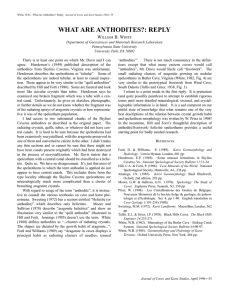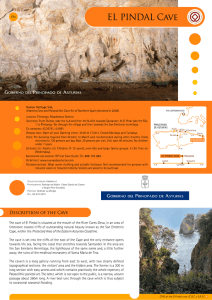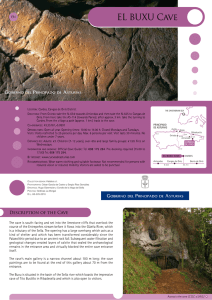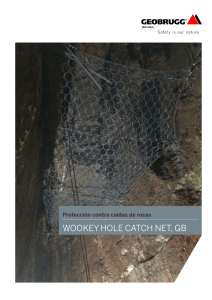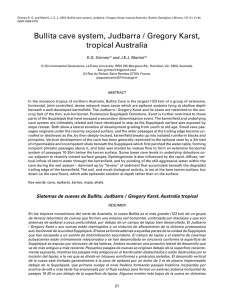Karst and Caves of the Black Hills, South Dakota, USA
Anuncio
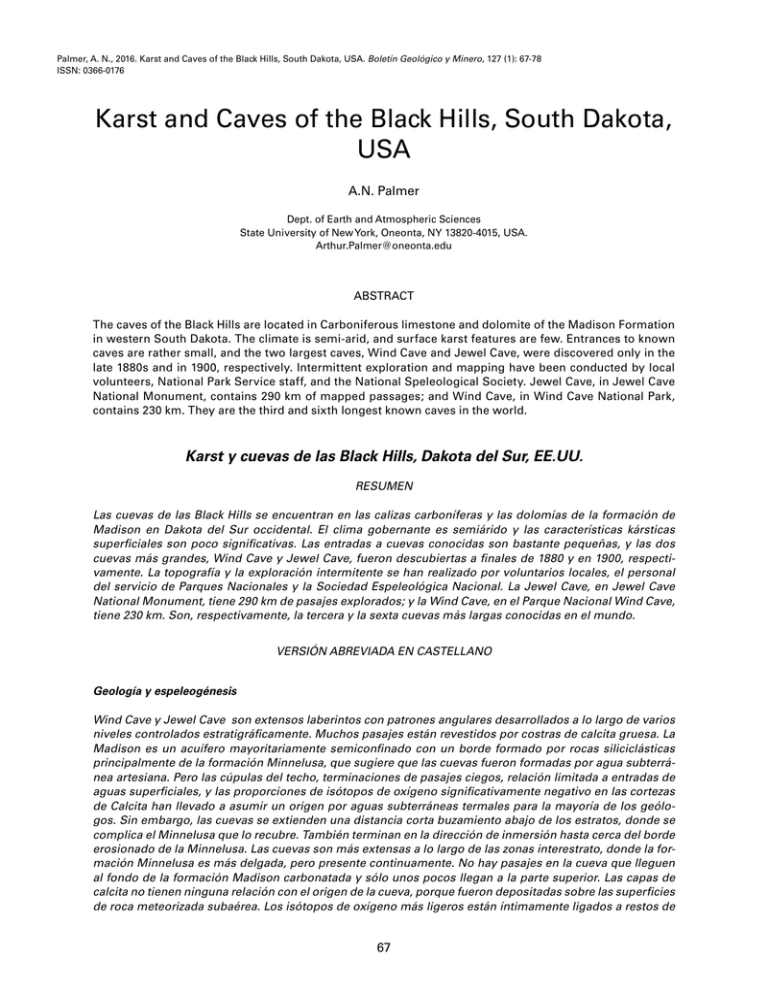
Palmer, A. N., 2016. Karst and Caves of the Black Hills, South Dakota, USA. Boletín Geológico y Minero, 127 (1): 67-78 ISSN: 0366-0176 Karst and Caves of the Black Hills, South Dakota, USA A.N. Palmer Dept. of Earth and Atmospheric Sciences State University of New York, Oneonta, NY 13820-4015, USA. [email protected] ABSTRACT The caves of the Black Hills are located in Carboniferous limestone and dolomite of the Madison Formation in western South Dakota. The climate is semi-arid, and surface karst features are few. Entrances to known caves are rather small, and the two largest caves, Wind Cave and Jewel Cave, were discovered only in the late 1880s and in 1900, respectively. Intermittent exploration and mapping have been conducted by local volunteers, National Park Service staff, and the National Speleological Society. Jewel Cave, in Jewel Cave National Monument, contains 290 km of mapped passages; and Wind Cave, in Wind Cave National Park, contains 230 km. They are the third and sixth longest known caves in the world. Karst y cuevas de las Black Hills, Dakota del Sur, EE.UU. RESUMEN Las cuevas de las Black Hills se encuentran en las calizas carboníferas y las dolomías de la formación de Madison en Dakota del Sur occidental. El clima gobernante es semiárido y las características kársticas superficiales son poco significativas. Las entradas a cuevas conocidas son bastante pequeñas, y las dos cuevas más grandes, Wind Cave y Jewel Cave, fueron descubiertas a finales de 1880 y en 1900, respectivamente. La topografía y la exploración intermitente se han realizado por voluntarios locales, el personal del servicio de Parques Nacionales y la Sociedad Espeleológica Nacional. La Jewel Cave, en Jewel Cave National Monument, tiene 290 km de pasajes explorados; y la Wind Cave, en el Parque Nacional Wind Cave, tiene 230 km. Son, respectivamente, la tercera y la sexta cuevas más largas conocidas en el mundo. VERSIÓN ABREVIADA EN CASTELLANO Geología y espeleogénesis Wind Cave y Jewel Cave son extensos laberintos con patrones angulares desarrollados a lo largo de varios niveles controlados estratigráficamente. Muchos pasajes están revestidos por costras de calcita gruesa. La Madison es un acuífero mayoritariamente semiconfinado con un borde formado por rocas siliciclásticas principalmente de la formación Minnelusa, que sugiere que las cuevas fueron formadas por agua subterránea artesiana. Pero las cúpulas del techo, terminaciones de pasajes ciegos, relación limitada a entradas de aguas superficiales, y las proporciones de isótopos de oxígeno significativamente negativo en las cortezas de Calcita han llevado a asumir un origen por aguas subterráneas termales para la mayoría de los geólogos. Sin embargo, las cuevas se extienden una distancia corta buzamiento abajo de los estratos, donde se complica el Minnelusa que lo recubre. También terminan en la dirección de inmersión hasta cerca del borde erosionado de la Minnelusa. Las cuevas son más extensas a lo largo de las zonas interestrato, donde la formación Minnelusa es más delgada, pero presente continuamente. No hay pasajes en la cueva que lleguen al fondo de la formación Madison carbonatada y sólo unos pocos llegan a la parte superior. Las capas de calcita no tienen ninguna relación con el origen de la cueva, porque fueron depositadas sobre las superficies de roca meteorizada subaérea. Los isótopos de oxígeno más ligeros están íntimamente ligados a restos de 67 Palmer, A. N., 2016. Karst and Caves of the Black Hills, South Dakota, USA. Boletín Geológico y Minero, 127 (1): 67-78 un paleokarst vacío existente antes del desarrollo de las cuevas principales. Ni el origen – agua artesiana o ascenso de aguas termales – parece capaz de dar cuenta de estas relaciones. En cambio, la configuración geológica, combinada con las mediciones químicas de agua moderna, sugiere un origen por la mezcla de dos fuentes: (1) infiltración difusa a través de la roca arenisca basal insoluble de la Minnelusa, que disuelve carbonatos en un sistema casi cerrado para lograr un muy bajo contenido de CO2; y (2) recarga lateral a través de los afloramientos de caliza expuesta de la Madison, con elevado contenido en CO2. Ambos estuvieron (y están) saturadas con carbonato cuando entran en las cuevas, pero debido a su contenido de CO2 producen una mezcla que es agresiva para los carbonatos y es importante en el tamaño de las cuevas conocidas con menos de 2 millones de años. Los análisis de U/Pb de las capas de calcita muestran que el origen de las cuevas de disolución tuvo lugar en el Oligoceno medio (Paleógeno tardío) y cesaron hace más de 25 millones años. Hoy en día, en el actual clima semiárido, las cuevas son esencialmente inactivas, reliquias, con un desarrollo insignificante. En comparación con casi todas las otras cuevas del mundo, son muy antiguas. La edad total de las cavernas es mucho mayor. La espeleogénesis continuó durante el Oligoceno en el paleokarst vacío de edad Carbonífero medio, que proporcionó las zonas de alta permeabilidad. Las cuevas presentes están revestidas por restos de paleokarst, incluyendo brechas cementadas, capas de roca corroída, venas de calcita y otros minerales, antiguas cuevas de origen meteórico y paleo-dolinas en parte o totalmente rellenas de sedimentos detríticos de una edad temprana en Minnelusa. El entierro profundo, principalmente por siliciclásticas Pérmico–Cretácico, de rocas sedimentarias conservan estas características hasta que fueron expuestos por levantamientos tectónicos y la erosión durante la orogenia Laramide (65- 30 millones de años atrás) y finalmente fueron agrandados para formar las cuevas objeto de este artículo. Depósitos en cavidades y procesos subaéreos Los eventos post-espeleogenéticos incluyen una profunda erosión de las paredes de roca seguido por una deposición de capas de calcita. La mayoría de la calcita se depositó aproximadamente hace 25 millones de años, cuando el agua que drenó el acuífero Madison alrededor de los bordes de las Black Hills estaban cubiertos por gruesas capas de sedimentos continentales y ceniza volcánica. Durante el Mioceno medio la erosión de los sedimentos continentales permitió que las cuevas drenaran el agua del interior. Los cambios climáticos durante la glaciación del Pleistoceno superior causaron inundaciones en la etapa tardía de los pasajes más interiores de la cueva, particularmente en la Wind Cave. Las afluencias ocasionales de agua ascendente de un acuífero profundo dio lugar a la deposición de manganeso y óxidos e hidróxidos de hierro, especialmente justo antes de la deposición de las capas de calcita. Durante los periodos de aireación la infiltración de agua se produjo en las cuevas como pequeñas gotas muy dispersas que forman depósitos de travertinos menores. Es mucho más significativo el efecto de las corrientes de convección en la cual, el aire profundo húmedo y caliente en las cuevas, se eleva a niveles superiores donde la humedad se condensa. Los depósitos de carbonato y la roca están corroídos intensamente en estas áreas. La humedad de condensación se mueve hacia abajo a lo largo de las superficies y a través de la roca de donde se evapora nuevamente. Los minerales carbonatados, incluyendo el aragonito y la hidromagnesita, son comunes en estas zonas. Las balsas de calcita se depositan sobre las superficies de los lagos y en áreas de pequeños arroyos. Los sitios de antiguos lagos están llenos de antiguas balsas de calcita. Futuras prospecciones Los estudios de flujo de aire sugieren que se ha descubierto sólo un minúsculo porcentaje del volumen de la cueva. En las entradas de la cueva se han medido vientos de hasta 100 km/h. Aunque tanto o más del volumen calculado debe consistir en aberturas demasiado pequeñas para que pueda entrar una persona. No obstante, el futuro de la exploración es muy prometedor. Cada año se descubren nuevos pasajes, especialmente en la Jewel Cave. Estudios de isótopos estables en las cuevas y técnicas mejoradas de datación están clarificando la historia geológica y climática de la región circundante. does not suggest karst recharge. However, some of the most extensive and geologically puzzling caves are hidden here. These mountains consist of an isolated eroded structural dome surrounded by plains. Their highest altitude is 2 207 m, with a relief of 1 200 m. The Introduction The Black Hills of South Dakota show little evidence that they are a world-class karst area. Surface karst features are scattered and obscure. A few large artesian springs show promise, but their steady flow 68 Palmer, A. N., 2016. Karst and Caves of the Black Hills, South Dakota, USA. Boletín Geológico y Minero, 127 (1): 67-78 main uplift took place from latest Cretaceous through Eocene (~65–30 million years ago) at the same time as the more impressive Rocky Mountains farther west. Precambrian metamorphic and igneous rocks form their mountainous center, and sedimentary strata of Cambrian through Cretaceous age dip away from them in all directions. Erosion of the strata has produced ring-shaped valleys and ridges that encircle the mountains (Figure 1). Nearly all of the karst is contained in the Madison Formation of Mississippian age (early Carboniferous), which consists of 100–180 m of limestone and dolomite (Figure 2). Much groundwater enters along its up-dip margin and flows in a semi-confined manner to the artesian springs around the perimeter of the hills, where the strata have been bowed upward in several anticlines that allow most of the water to rise along fractures to the surface. The Madison is capped by the Minnelusa Formation, consisting of about 100–200 m of various rock types, but mainly sandstone at the base. It forms the semi-confining cap for most of the Madison aquifer. Two Strange Caves Two caves are enough to establish the Black Hills as a remarkable karst area: Wind Cave and Jewel Cave (Figs. 3 and 4). These are extremely complex three-dimensional mazes, which together contain almost 500 km of mapped passages. To geologists their main attraction is a long, complicated, and highly debated origin. Today the caves lie almost entirely above the water table, and speleogenesis has more or less ceased. Wind Cave National Park, at the southeastern Figure 2. Simplified geologic cross section through Wind Cave, showing pattern of regional water flow, and possible paths of water during cave origin. The distance from cave to spring is about 8 km, with relief of ~200 m. Cave = black; 1 = Precambrian rocks; 2 = Cambrian Deadwood Sandstone; 3 = Madison Formation (limestone and dolomite); 4 = Minnelusa Formation (mainly insoluble, sandstone at base); 5 = late Paleozoic; 6 = Mesozoic; (A) inflow from the surface through outcrops of Madison Formation; (B) diffuse seepage through the basal sandstone of the Minnelusa Formation; (C) deep flow through underlying Precambrian rocks; (D) water rising along strata from deep sources. See text for discussion. Figura 2. Sección geológica simplificada a través de la Wind Cave, mostrando el modelo de flujo regional y posibles vías de agua durante el origen de la cueva. La distancia desde la cueva a los manantiales es de 8 km con un relieve de 200 m. Cueva= negro; 1= rocas precámbricas; 2= Arenas Deadwood del Cámbrico; 3= Formación Minnelusa (principalmente insoluble, arenas en la base); 4= Formación Madison (calizas y dolomías); 5= Paleozoico superior; 6= Mesozoico; 7= (A) Infiltración desde la superficie a través de afloramientos de la Formación Madison; (B) flujo difuso a través de las arenas basales de la Formación Madison; (C) Flujo profundo a través de los estratos de rocas Precámbricas; (D) agua ascendiendo a través de estratos desde zonas profundas. Ver discusión en el texto. Figure 1: Black Hills location map and geology. Figure 1. Mapa de localización de las Black Hill y geología. 69 Palmer, A. N., 2016. Karst and Caves of the Black Hills, South Dakota, USA. Boletín Geológico y Minero, 127 (1): 67-78 Figure 3. Maps of Jewel Cave and Wind Cave, courtesy of the National Park Service, up to 2003. Figura 3. Mapa de la Jewel Cave y la Wind Cave, cortesía del Servicio del Parque Nacional, hasta 2003. edge of the Black Hills, includes not only the cave, but also a surface refuge for wildlife, which includes a large herd of American bison (commonly known as buffalo). Jewel Cave National Monument is much smaller, but its cave is larger. There are hundreds of other caves in the Black Hills. Most of them resemble Wind and Jewel in some ways, but they are much smaller. The Madison Formation is composed of three units, each about 30–50 m thick, and each with a distinctive influence on the caves. The lowest unit is mostly massive fractured dolomite. Passages in it are sparse and consist almost entirely of linear fracture-controlled fissures. The middle unit consists of interbedded limestone and dolomite. Its passages are highly irregular and follow a variety of fractures and bedding, forming complex networks on several different levels. Thin chert beds are common at the top of this unit and in places they form a barrier between cave levels. The upper unit is massive limestone that contains rambling smooth-walled rooms. These generally terminate upward in domed ceilings and cupolas. Both Wind and Jewel contain several tiers of cave development, all controlled mainly by strata rather than erosional history. Passage profiles show the strong influence of stratal dip (Fig. 2). The caves contain almost no clastic sediment (sand, gravel, cobbles), except for a few sparse deposits near entrances. Both caves intersect relics of much-older caves of Paleozoic origin, described below as paleokarst. Although the two caves resemble each other in passage pattern, they are quite different in detail. The scale of Jewel Cave is about twice that of Wind Cave in passage size and extent. Most of the passages in Jewel are coated with a layer of calcite crystals averaging 15 cm thick (Fig. 4, left). This coating Figure 4. Left: Scenic Route in Jewel Cave, showing thick calcite crust. Right: Blue Grotto Route in Wind Cave, with box-work in the ceiling. All photos by A.N. Palmer, except where noted otherwise. Figura 4. Izquierda; Ruta escénica en la Jewel Cave, mostrando potentes láminas de calcita. Derecha: Ruta Blue Grotto en la Wind Cave, con zonas box-worken el techo. Fotos de A.N. Palmer excepto donde se señala lo contrario. 70 Palmer, A. N., 2016. Karst and Caves of the Black Hills, South Dakota, USA. Boletín Geológico y Minero, 127 (1): 67-78 is absent only where it has peeled off the walls or has been dissolved by condensation moisture from rising vapor. Small amounts of anoxic water have risen into the cave late in its history, producing layers of manganese dioxide that range from a thin glaze to beds up to 20 cm. In places they coat everything black – including explorers. In contrast, Wind Cave has extremely irregular walls with jagged projections and many openings of all sizes leading in every direction (Fig. 4, right). Boxwork is abundant, mainly in the middle levels. This consists of calcite fins that project outward from rock surfaces. It is not common in Jewel Cave. The lowest levels of Wind Cave are coated with a smooth calcite crust that is much thinner than that in Jewel. The deepest passages in both caves extend down to small lakes at the water table (Fig. 5). Exploration The tiny natural entrance of Wind Cave was long known to native Americans because of its strong winds that blow in and out with changes in atmospheric pressure (Fig. 6). The first major exploration took place in 1890 when it became part of a mining claim. The manager, his family, and associates explored deep into the cave, following a maze of intersecting passages that seemed to have no end. Through 1899 they offered guided tours of the cave. Wind Cave National Park was established in 1903, but little further exploration took place until the 1950s, when the National Speleological Society (NSS) made discoveries leading southeast. In the 1960s, Herb and Jan Conn, well-known Jewel Cave explorers, doubled the known length of the cave, finding large rooms and a deep lake at the southern end. Since then, NSS and National Park Service cavers have pushed the cave to its present 230 km, sixth longest in the world (Fig. 3, right). Jewel Cave was discovered in 1900, when two local brothers found a narrow cliff-side fissure exhaling air. Enlarging it with dynamite, they found chambers lined by many large calcite crystals, which inspired the cave name. They ran guided tours until Jewel Cave National Monument was established in 1908. In 1959 caver Dwight Deal obtained a permit to study the cave for a geology thesis. He and his local climbing friends Herb and Jan Conn soon mapped 8 km of passages. The Conns continued exploring and surveying after Dwight left the area, and discovered a large area suitable for a new tour. A 76 m elevator shaft was installed from a new visitor center, and the new “Scenic Tour” opened in 1972 (Conn & Conn, 1977). The Conns retired from caving in 1983, but their work was continued by Monument employee Mike Wiles and NSS teams. Now at 290 km, Jewel Cave is the world’s third longest (Fig. 3, left). Exploring these caves is a challenge. Passages extend in all directions, and explorers often find it difficult to decide whether they are following a distinct passage at all. Profiles in both caves are highly irregular, and travel through even the large parts requires much effort. Exploration to the known limits of either cave is hindered by many extremely tight places that filter out all but the thinnest cavers. Names such as Les Misérables in Wind Cave and the VARD (Victory after Reducing Diet) in Jewel Cave are well justified. Fortunately the caves are almost entirely dry. Figure 5. Windy City Lake represents the water table at the deepest point in Wind Cave. Note the thin calcite crust of late Pleistocene age (<300 000 yrs). Figura 5. El lago Windy City representa el nivel freático en el punto más profundo en la Wind Cave. Hay que tener en cuenta la lámina delgada de calcita de edad Pleistoceno superior (< 300 000 años). 71 Palmer, A. N., 2016. Karst and Caves of the Black Hills, South Dakota, USA. Boletín Geológico y Minero, 127 (1): 67-78 above sea level, when surface karst and caves developed in the upper Madison to depths as much as 40 m. This erosional episode is the reason why the Carboniferous of North America is divided into the Mississippian and Pennsylvanian Periods at ~320 million years ago. The earliest Minnelusa deposits filled sinkholes, surface fissures, and some caves with sand, clay, and fragments of local rock. Some of the present cave passages terminate in the paleokarst fill, and many of the upper-level rooms appear to be enlarged paleo-caves (Fig. 7). Before this karst episode there was an earlier phase of bedrock alteration that took place soon after the limestone was deposited. Some of the resulting features are shown in Fig. 8. These rocks originally contained much anhydrite (CaSO4 ) and gypsum (CaSO4 2H2O), especially in the middle unit of the Madison. Dissolution, plastic flow, and hydration of the sulfates soon caused the surrounding strata to become fractured and brecciated. Some sulfate was reduced to hydrogen sulfide (H2S) and pyrite (FeS2) by reaction with local organic material. Gradual uplift late in the Mississippian Period exposed the Madison at the surface, allowing oxygen-rich water to infiltrate into the limestone and oxidize the sulfides to sulfuric acid. The acid corroded and dissolved the surrounding carbonates, forming small caves and converting some of the carbonates to secondary gypsum. As meteoric water became dominant, it dissolved most of the remaining gypsum, and the rest was replaced by calcite by the common-ion effect (in which calcium from the dissolving gypsum forced calcite to precipitate from the calcite-saturated water). The calcite is colored a distinct red-brown from the pyrite oxidation and contains fossil filaments of iron-oxidizing bacteria. This calcite forms the breccia matrix seen in cave walls and apparently also the boxwork veins. These calcite veins now project into the caves as much as a meter, but they extend only about 10 cm into the bedrock of the cave walls. These early features include solutional openings up to a meter in diameter. They qualify as a separate paleokarst event that pre-dated the well-known Mississippian-Pennsylvanian karst. They are barely recognizable at the land surface but are well exposed in the caves. Much of the chaotic appearance of the present caves is inherited from these two events, which span the time from about 330 to 310 million years ago. They are far older than the main phase of cave origin, which took place after the mountains were uplifted. The Black Hills caves have experienced three separate and quite different phases of cave development! Figure 6. The original “blowhole” entrance of Wind Cave. Two artificial entrances have been installed (one via elevator), and a narrow surface fissure at the northwestern end of the cave was connected to the cave a few decades ago. Figura 6. La entrada original “blowhole” de la Wind Cave. Dos entradas artificiales han sido instaladas (uno vía ascensor), y una estrecha fisura superficial situada en el extremo noroeste de la cueva que fue conectada hace unas décadas. Air movement in the most remote explored parts of Jewel is almost as strong as at the entrance. Wind Cave has ferocious winds at its entrance, but they dissipate rapidly a short distance into the cave, where only mild air currents can be detected. Air-flow studies suggest that only a small percentage of the true cave volume has been explored (Conn, 1966; Pflitsch & Ringeis, 2009). The two caves seem to have different responses to outside atmospheric pressure, so a connection cannot be demonstrated. Each cave can be explored far beyond its presently known size. Paleokarst At the top of the Madison Formation is an extensive paleokarst zone that was buried by the Minnelusa Formation. It represents a lengthy period of exposure 72 Palmer, A. N., 2016. Karst and Caves of the Black Hills, South Dakota, USA. Boletín Geológico y Minero, 127 (1): 67-78 Figure 8: Features from early bedrock alteration prior to the main paleokarst, related to sulfate-carbonate interactions: (a) Breccia with brown calcite matrix and solutional void lined by later deep-burial white calcite – Jewel Cave. (b) Corrosion of bedrock by sulfuric acid, with protruding veins of former gypsum (now calcite) – Wind Cave. (c) Boxwork in Wind Cave. (d) Microscopic thin section of brown calcite containing iron oxide bodies and fossil filaments of iron-oxidizing bacteria (photo by Margaret V. Palmer) – Jewel Cave. Figura 8. Formas de alteración temprana de estratos del principal paleokarst relacionadas con las interacciones sulfato-carbonato: (a) Brecha con matriz de calcita marrón y vacío de disolución alineado por posterior enterramiento profundo con calcita blanca – Jewel Cave. (b) la corrosión del lecho rocoso por ácido sulfúrico, con vetas de yeso anterior (ahora calcita) – Wind Cave. (c) Boxwork en la Wind Cave. (d) Visión microscópica de la lámina delgada de los cuerpos de óxido de hierro que contienen la calcita marrón y filamentos fósiles de bacterias oxidantes del hierro (foto Margaret V. Palmer) – Jewel Cave. Figure 7: Pennsylvanian fill in the Jewel Cave filling. The rocks are mainly slabs of limestone and chert from the upper Madison Formation. Pockets in the sediment have been lined by later calcite. Figura 7. El relleno Pensilvaniense en la Jewel Cave rellenado el paleokarst del Mississippi. Las rocas son principalmente capas de piedra caliza y sedimentos silíceos de la upper Madison Formation. Hay bolsas de sedimento que se han recubierto posteriormente por calcita. Controversies about Cave Origin Over the past century the Black Hills caves have been interpreted in several different ways, and the topic still causes lively debate. Most researchers consider only the main phase of cave growth, when they were enlarged to their present size after the uplift of the Black Hills. But in doing so, they overlook the effects of the two paleokarst events described above. An artesian cave origin for the caves seems an obvious possibility because that is the nature of the Madison aquifer (Tullis and Gries, 1938; Deal, 1962; Howard, 1964; Fig. 2). But the fact that the Black Hills caves do not extend far down the dip of the aquifer is a serious argument against this kind of origin. A strong case has been made for an origin by thermal and/or rising water (Figs. 2 and 9). Owen (1898), having just visited the geysers and hot springs of Yellowstone National Park, saw many similarities with Wind Cave. White & Deike (1962) noted crystalline quartz and hematite in Wind Cave, which they interpreted as thermal. This is correct, but these minerals are relics of deep-seated mineralization that 73 Palmer, A. N., 2016. Karst and Caves of the Black Hills, South Dakota, USA. Boletín Geológico y Minero, 127 (1): 67-78 indicate high temperature, they apply mainly to calcite that formed in pockets at great depth beneath the surface and thus pre-dates the caves. The Black Hills caves are almost everywhere overlain by the thin up-dip edge of the Minnelusa Formation, where it consists mostly of interbedded sandstones and carbonates (Fig. 2). In the downdip direction, where the remaining Minnelusa is thick, there are no underlying caves. And where the Minnelusa has been eroded away, cave passages are small and sparse, or entirely absent. This pattern suggests that diffuse infiltration through the sandstone-rich beds of the Minnelusa must have played a role in cave genesis. But this source alone would not be sufficient. Palmer and Palmer (1989) attributed the caves to the mixing of waters from two or more sources with contrasting CO2 content (see Bögli, 1964). Infiltration through the thin Minnelusa is one obvious source. Lateral inflow through the Madison outcrop is another, because that is the main recharge to the confined aquifer (Fig. 2). Both waters appear to have entered the cave while almost completely saturated with calcite, then mixed below the former water table. Because of their different concentrations of carbon dioxide, they would have formed an undersaturated mixture able to enlarge the paleokarst voids slowly into the caves that we see today. Some explanation is needed. Where seepage through sandstone later encounters limestone in a system closed to air, the CO2 content decreases to below 0.0001 atmosphere (Palmer and Palmer, 2013). Chemical measurements by Back (2011) of drips entering Wind Cave yield a PCO2 of 0.0006 atm. In contrast, water entering from the Madison outcrop has values of roughly 0.003 atm. Because of their slow seepage rates, both waters are essentially saturated with dissolved calcite, but mixing of the two would allow an additional 0.002 cm3 /L to be dissolved (Fig.10). Today’s dripwater has already absorbed some CO2 from the cave air, and water from the limestone outcrop area has already lost some CO2 to the cave air. The original contrast would therefore have been even greater, and so would its capacity to dissolve limestone. Measurements of infiltration through the thin Minnelusa into the caves by Wiles (1992) suggest a total of nearly 12 000 m3 /yr/km2. Combined with the water from the limestone outcrop, the mixture could have dissolved the entire cave volume in about 1–3 million years. This time span was easily available in the nearly static topography of the mid- Oligocene, when the caves reached their present size (see Geologic History below). Dissolution would have Figure 9: Features often used to support thermal cave origin, but which do not apply to the main speleogenesis: (a) Quartz crystals, thermal, but formed at depth during early stages of mountain uplift – Wind Cave. (b) Calcite (“dogtooth spar”) with highly negative δ18O values, formed during deep burial prior to mountain uplift – Jewel Cave. (c) Ceiling cupolas, often considered the result of convection in thermal water, but instead (at least here) formed by condensation corrosion in air – Reeds Cave (between Wind and Jewel Caves). Figura 9. Formas usadas a menudo para sostener el origen termal de la cueva pero que no se aplican a la espeleogénesis principal: (a), cristales de cuarzo, termales, formados en profundidad durante las primeras etapas de levantamiento de la montaña – Wind Cave. (b) calcita (“diente de perro”) con valores de δ18O altamente negativos, formados durante el enterramiento profundo antes de la elevación de la montaña – Jewel Cave. (c) cúpulas del techo, a menudo considerado el resultado de la convección en agua termal, pero (al menos aquí) formado por corrosión de condensación del aire – Reeds Cave (entre la Wind and Jewel Caves). pre-date the present caves. Bakalowicz et al. (1987) and Ford (1989) showed further evidence for a thermal origin – thick calcite crusts with light oxygen isotope ratios (δ18O as low as –21‰), solutional cupolas, and maze patterns resembling those of thermal Budapest caves. But the calcite was deposited on walls that had previously been deeply weathered in air, so it has no direct relation to the cave origin. And although the lightest oxygen isotope ratios do 74 Palmer, A. N., 2016. Karst and Caves of the Black Hills, South Dakota, USA. Boletín Geológico y Minero, 127 (1): 67-78 concentrated well below the top of the Madison, and the unusual flow pattern is difficult to explain. Geologic History of the Black Hills Caves It is now possible to construct an outline of the major events that produced the caves that we see today in the Black Hills. 1. Deposition of shallow marine carbonates during the early Carboniferous Period. These were interbedded with evaporitic sulfates that correlate with others that still remain in nearby sedimentary basins. Sulfates were concentrated mainly in the middle unit of the Madison. 2. Instability of the sulfates caused plastic deformation, recrystallization, and hydration of anhydrite to gypsum. Adjacent carbonate rocks were fractured and brecciated (Fig. 8). Gypsum formed the breccia matrix and filled narrow fractures. 3. Some of the sulfates were reduced to hydrogen sulfide (H2S) and pyrite (FeS2). This required the presence of organic material, but the source is still uncertain. There may be a link to minor petroleum reservoirs that still remain in adjacent strata in the southwestern Black Hills. 4. Mild tectonic uplift (Antler orogeny) exposed the limestone at the surface, allowing infiltration of oxygen-rich meteoric water. Sulfides oxidized to sulfuric acid, which enlarged voids in the brecciated carbonates. Remaining sulfates were immune to H2SO4 dissolution. 5. Increased infiltration of carbonate-rich water replaced the remaining sulfates with red-brown calcite. The present breccia matrix and boxwork veins are composed of this calcite (Fig. 8c). U/Pb dating of the calcite supports this history but further calibration is needed before details can be released (dates by Victor Polyak, University of New Mexico; see Palmer et al., 2009). 6. Exposure at the surface allowed infiltrating water to produce surface karst (sparse dolines and fissures), and to mix with saline water to form a cavernous zone about 25–40 m below the top of the Madison . This is the well-known paleokarst at the Mississippian-Pennsylvanian boundary, which extends throughout much of the western USA (Sando, 1988). It is concentrated in the uppermost unit of the Madison and intersects the earlier karst features of the middle Madison (stages 2–5) in only a few places. 7. The mainly insoluble Minnelusa Formation was deposited (late Carboniferous) and filled most of the paleokarst voids from stage 6 (Fig. 7). 8. Continued accumulation of sediments through the Cretaceous buried the Madison to depths of Figure 10: Graph of calcite solubility vs. partial pressure of CO2 at 12 ºC, showing the increase in calcite solubility caused by mixing between the two main calcite-saturated water sources entering the caves: (A) = low-CO2 water from closed-system infiltration through alternating sandstone and limestone. (B) = high-CO2 water from infiltration through soil directly into limestone in the Madison outcrop area. (C) = representative mixture (1:1 in this example). (D) = final calcite solubility. The slope of the dissolution path is caused by consumption of CO2 as calcite is dissolved in a closed system. C - D= gain in calcite solubility caused by the mixing (22 mg/L = 0.0081 cm3/L), compared to the average solubility of the two waters. However, because the inflow of A is generally much less than B, the total dissolution can be can be calculated simply by increasing the CO2 content of the infiltration water from 0.0006 to 0.003 atm, as explained in the text. Figura 10. Gráfico de solubilidad de calcita vs presión parcial de CO2 a 12º C, mostrando el aumento en la solubilidad de calcita causada por la mezcla entre dos fuentes principales de agua saturada en calcita cuando entra en las cuevas: (A) = agua con bajo contenido en CO2 de un sistema cerrado infiltrándose a través de calizas y areniscas. (B) = agua con alto contenido en CO2 infiltrándose a través del suelo directamente en la roca caliza en la zona de afloramiento de formación Madison. (C) = representativa mezcla (1:1 en este ejemplo). (D) = solubilidad final de la calcita. La pendiente de la recta de disolución es causada por el consumo de CO2 debido a que la calcita se disuelve en un sistema cerrado. C-D = aumento en la solubilidad de calcita causada por la mezcla (22 mg / L = 0.0081 cm3/L), en comparación con la solubilidad media de las dos aguas. Sin embargo, debido a la afluencia de la A es generalmente mucho menor que B, puede ser la disolución total que se calcula simplemente incrementando el contenido de CO2 de las aguas de infiltración de 0.0006 a 0.003 atm, como se explica en el texto. been concentrated beneath the thin parts of the Minnelusa, where the caves are located today. The stratigraphic position and the irregular shapes of the caves are also compatible with this origin. Wiles (2005, and personal communication since) agrees that cave development relied on diffuse infiltration through the Minnelusa. However, he attributes the caves to lateral flow through the sandstone, accompanied by many downward loops into the Madison and then back up again to form the caves. The main difficulties are that the caves are most 75 Palmer, A. N., 2016. Karst and Caves of the Black Hills, South Dakota, USA. Boletín Geológico y Minero, 127 (1): 67-78 about 1.5–2 km. During deep burial, crystalline white calcite was deposited in voids in the limestone and early sediment fill (Figs. 8a and 9a). Low δ18O values (to –21‰ ) indicate high temperature but because of depth, not thermal cave origin. Uranium content is too small for U/Pb dating. 9. The Black Hills rose during the Laramide Orogeny (latest Cretaceous to approximately late Eocene). Quartz crystals were deposited along faults and in neighboring voids during uplift (Fig. 9b). These suggest high temperatures, but again are not related to cave origin. Erosion exposed the Precambrian rocks in the center of the uplift and the eroded edges of sedimentary strata around the margins. 10. As the Madison Formation was eroded back from the central Black Hills, it received increasing amounts of groundwater flow. Caves probably formed throughout this time, but rapid erosion limited their size. The present caves formed only after the topography had evolved almost to its present state, probably in early-mid Oligocene, by mixing between infiltration through the Minnelusa and water from the limestone outcrop. Boxwork veins protruded into the caves. Paleokarst voids were intersected, including many that had not been filled by Minnelusa sediment. 11. Drying climate caused the caves to drain, allowing deep weathering of the cave walls. Speleogenesis ceased. 12. Near the end of the Oligocene the caves were re-flooded with groundwater, which deposited the thick calcite crust seen best in Jewel Cave (Fig. 4, left). Remnants are still present in Wind Cave but most have been weathered away. The base of the crust in Jewel Cave has a U/Pb date of 25 million years, when sediments accumulated on the plains around the Black Hills and other Rocky Mountains (Figs. 1, 11). The calcite crust began to form when the springs draining the Madison aquifer were covered with enough sediment to block their flow. 13. The upper surface of the crust has a date of 14.7 million years, which represents erosional removal of the sediment from the spring areas by increasing stream erosion in the mid-Miocene. Many Oligocene deposits remain around Wind Cave. It is valid to consider the burial of the caves and springs, and later exhumation, to represent a third phase of paleokarst! 14. In Wind Cave the water table fluctuated during the late Pleistocene (last 300 000 years), depositing a multi-layer calcite crust up to 2 cm thick in the lowest passages (Fig. 5). U/Th dating was made by Ford et al., 1993, and in 2012 by James Paces, U.S. Geological Survey. 15. Vadose speleothems were deposited during subaerial exposure (stages 11, 13, & 14, and Figure 11: Oligocene sediments of the White River Group, in Badlands National Park, east of the Black Hills. At their greatest extent (~25 million years ago) these deposits blocked the springs that drained the large Black Hills caves and caused calcite to deposit on the cave walls. Later (~14.7 million years ago) the sediment was eroded away from the springs and the caves drained. Figura 11. Sedimentos oligocenos del grupo de Río Blanco, en el Parque Nacional de Badlands, al este de las Black Hills. En su mayor desarrollo (hace 25 millones de años) estos depósitos bloquearon los manantiales que drenan a las grandes cuevas de las Black Hills y precipitaron calcita en las paredes de la cueva. Más adelante (~14.7 millones de años atrás) el sedimento fue erosionado de las surgencias lo que permitio el drenaje de las cuevas. continuing today). These included very minor stalactites, stalagmites, and flowstone. More common were evaporative deposits, including aragonite bushes (Fig. 12). Moist air rose in convection cells and caused condensation on colder rock surfaces. Dissolution by this process produced domes, cupolas, and smooth corroded surfaces (Fig. 9c). High-level calcite crusts were partially or completely removed by this process. These features give the false impression of dissolution by hypogenic water. Drip-water continues to corrode the cave surfaces today, especially in Wind Cave, but the infiltration rate is less than in the past, and the boost in dissolution caused by mixing with carbonate-rich groundwater 76 Palmer, A. N., 2016. Karst and Caves of the Black Hills, South Dakota, USA. Boletín Geológico y Minero, 127 (1): 67-78 is no longer present. Today the Oligocene sediments are still being removed from low areas of the southeastern Black Hills. The relationship of the caves to the surrounding geology show that the landscape has changed very little since the caves were last enlarged more than 25 million years ago (Fig. 13). Discussion This story is complex, and readers may imagine that it contains many wild guesses. But visual evidence for all of these events is well preserved in the caves and has been confirmed by repeated petrographic studies, geochemical associations, and quantitative dating (Palmer and Palmer, 2008; Palmer et al., 2009). In some places (e.g., the room at the base of the elevator in the Jewel Cave), it is possible to see almost all of the diagnostic features together in their appropriate relationships. Many of them are known in other karst areas, but perhaps nowhere else do they all occur in the same location. There is still some debate about the cave origin, and perhaps there always will be; but the data overwhelmingly favor the mixing process described here. During the Eocene, the northern Black Hills experienced igneous intrusions and mineralization, and the effects may have been felt as far south as Wind and Jewel Caves. At various times iron and manganese oxides were deposited in the caves along faults. Figure 12: Evaporative aragonite speleothems in Jewel Cave. Width of photo ~20 cm. Figura 12. Espeleotemas de aragonito evaporítico en la Jewel Cave. Anchura de la foto ~ 20 cm. Although no major thermal mineralization has yet been identified in the caves, the possibility should be considered. One of the strangest aspects of the caves is that they terminate so abruptly in certain directions, and that many large sections are connected by very small passages. For example, the northeastern edge of Wind Cave is so linear that it appears to have been cut by a fault (Fig. 3). However, the passages simply end in solid Figure 13. Landscape over Wind Cave, an exhumed Oligocene surface. Figura 13. Paisaje sobre la Wind Cave, con una superficie exhumada de edad Oligoceno. 77 Palmer, A. N., 2016. Karst and Caves of the Black Hills, South Dakota, USA. Boletín Geológico y Minero, 127 (1): 67-78 Howard, A.D., 1964, Model for cavern development under artesian ground water flow, with special reference to the Black Hills. National Speleological Society Bulletin, 26, 7–16. Owen, L.A., 1898, Cave regions of the Ozarks and Black Hills. The Editor Publishing Co., Cincinnati, OH, USA, 217 p. Palmer, A.N. and Palmer, M.V., 1989, Geologic history of the Black Hills caves, South Dakota. National Speleological Society Bulletin, 51 (2), 72-99. Palmer, A.N. and Palmer, M.V., 2008, Field guide to the paleokarst of the southern Black Hills. In: Sasowsky, I., Feazel, C., Mylroie, J., Palmer, A., and Palmer, M. (eds.), Karst from recent to reservoirs: Karst Waters Institute, Leesburg, VA, USA, Special Publication 14, p. 189–220. Reprinted in Engel, A., & Engel, S. (eds.), 2009, Select field guides to cave and karst lands of the United States. Karst Waters Institute, Leesburg, VA, USA, p. 133–174. Palmer, A., Palmer, M., Polyak, V. and Asmerom, Y., 2009, Geologic history of the Black Hills caves, South Dakota, USA. 15th International Congress of Speleology, Kerrville, TX, Proceedings v. 2, p. 946–951. Palmer, A. and Palmer, M., 2013, Effects of CO2-depleted vadose seepage in karst. 16th International Congress of Speleology, Brno, Czech Republic, Proceedings, v. 3, p.393–398. Pflitsch, A. and Ringeis, J., 2009. Jewel Cave and Wind Cave vs. one Black Hills cave system. 15th International Congress of Speleology, Kerrville, TX, Proceedings, v. 3, p. 1632–1636. Sando, W., 1988, Madison Limestone (Mississippian) paleokarst: A geologic synthesis. In: James, N., and Choquette, P., eds., Paleokarst. Springer-Verlag, New York, p. 256–277. Tullis, E.L. and Gries, J.P., 1938, Black Hills caves. The Black Hills Engineer, 24 (4), 233-271. White, W. and Deike, G., 1962, Secondary mineralization in Wind Cave, South Dakota. National Speleological Society Bulletin, 24, 74–87. Wiles, M., 1992, Infiltration at Wind and Jewel Caves, Black Hills, South Dakota. M.S. thesis, South Dakota School of Mines and Technology, Rapid City, SD, USA, 70 p. Wiles, M., 2005, Mapping surface geology to protect cave and karst resources of the Jewel Cave System [abstract]. Proceedings, 17th National Cave and Karst Management Symposium, Albany, NY, USA, p. 165. walls, with no breakdown or sediment fill, and only tiny impenetrable holes continuing beyond. In nearby surface canyons there are no large concentrations of cave passages in the limestone walls – only a few sediment-choked paleokarst pockets. The caves have developed mainly in the zones of early sulfate rocks, guided by the associated bedrock alteration, breccia, and solution pockets, and by the major paleokarst features that followed them. In many places these early features set the limits for the present caves. Information from the caves is of great help in interpreting the geologic history of the region. But these interpretations will certainly continue to evolve as new data become available. References Back, J., 2011, Geochemical investigation of the Madison aquifer, Wind Cave National Park, South Dakota. National Park Service, Natural Resource Technical Report NPS/NRPC/WRD/NRTR–2011/416, 50 p. Bakalowicz, M., Ford, D., Miller, T., Palmer, A. and Palmer, M., 1987, Thermal genesis of dissolution caves in the Black Hills, South Dakota. Geological Society of America Bulletin, 99, 729–738. Bögli, A., 1964, Mischungskorrosion, ein Beitrag zur Verkarstungs-problem [Mixing corrosion, a contribution to the karst problem]. Erdkunde, 18, 83–92. Conn, H., 1966, Barometric wind in Wind and Jewel Caves, South Dakota. National Speleological Society Bulletin, 28, 2, 55–79. Conn, H., and Conn, J., 1977, The Jewel Cave adventure. Zephyrus Press, Teaneck, NJ, USA, 238 p. + map. Deal, D.E., 1962, Geology of Jewel Cave National Monument, Custer County, South Dakota. M.A. thesis, University of Wyoming, Laramie, WY, USA, 183 p. Ford, D.C., 1989, Features of the genesis of Jewel Cave and Wind Cave, Black Hills, South Dakota. National Speleological Society Bulletin, 51 (2), 100-110. Ford, D., Lundberg, J., Palmer, A., Palmer, M., Schwarcz, H., & Dreybrodt, W., 1993, Uranium-series dating of the draining of an aquifer: The example of Wind Cave, Black Hill, South Dakota. Geological Society of America Bulletin, 05, 241–250. Recibido: febrero 2015 Revisado: marzo 2015 Aceptado: abril 2015 Publicado: marzo 2016 78
